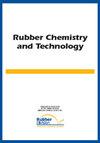包括温度效应的现象和微机械摩擦公式的比较
IF 1.5
4区 工程技术
Q4 POLYMER SCIENCE
引用次数: 0
摘要
轮胎是车辆与道路的唯一接触点,对行车安全起着重要作用。在最近的过去,两种不同的摩擦配方占主导地位。现象学方法制定了一个数学表达式来描述实验结果。通过知识和经验,公式内插和外推实验捕捉到的行为。然而,配方在很大程度上取决于实验质量及其影响因素。因此,引入了第二类摩擦模型,即微力学方法。摩擦运动学是根据橡胶在接触区滑动时在广义表面上的变形来描述的。其基本思想是仅通过表面特性和材料特性来获得摩擦系数。两种方法各有优缺点,难以区分,哪一种方法更适合在某种应用中使用。在这篇文章中,讨论并比较了不同的摩擦公式。橡胶的力学性能受温度的强烈影响,其摩擦特性也受温度的强烈影响。因此,摩擦公式相对于温度展开。在轮胎转弯模拟中,对所讨论的与温度有关的摩擦公式进行了比较。大滑移角下的转弯刚度降低可以用摩擦引起的接触区温度升高来解释。本文章由计算机程序翻译,如有差异,请以英文原文为准。
A comparison of phenomenlogical and micromechanical friction formulations including temperature effects
ABSTRACT Tires are the only contact points between vehicle and road and are mainly responsible for the driving safety. In the recent past, two different classes of friction formulations are predominant. Phenomenological approaches formulate a mathematical expression to describe the experimental results. By knowledge and experience, the formulations interpolate and extrapolate the behaviour captured by experiments. However, the formulations are highly dependent on the quality of the experiments and its influence factors. Therefore, a second class of friction models have been introduced, micromechanical approaches. The friction kinematics is described based on the deformation of the rubber in the contact zone, while sliding over a generalized surface. The basic idea is to obtain the friction coefficient solely by the surface properties and the material behaviour. As both approaches have advantages and disadvantages, it is hard to distinguish, which is more suitable to use in a certain application. In this contribution, different friction formulations are discussed and compared to each other. The mechanical behaviour of rubber is strongly influenced by temperature and so are its friction characteristics. Therefore, the friction formulations are expanded with respect to temperature. The discussed temperature dependent friction formulations are compared to each other for tire cornering simulations. The decrease of the cornering stiffness at large slip angles can be explained by friction induced temperature increase in the contact zone.
求助全文
通过发布文献求助,成功后即可免费获取论文全文。
去求助
来源期刊

Rubber Chemistry and Technology
工程技术-高分子科学
CiteScore
3.50
自引率
20.00%
发文量
21
审稿时长
3.6 months
期刊介绍:
The scope of RC&T covers:
-Chemistry and Properties-
Mechanics-
Materials Science-
Nanocomposites-
Biotechnology-
Rubber Recycling-
Green Technology-
Characterization and Simulation.
Published continuously since 1928, the journal provides the deepest archive of published research in the field. Rubber Chemistry & Technology is read by scientists and engineers in academia, industry and government.
 求助内容:
求助内容: 应助结果提醒方式:
应助结果提醒方式:


